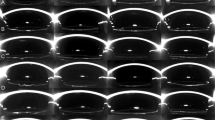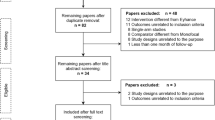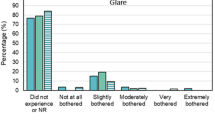Abstract
Purpose
To evaluate the effect of mild posterior capsule opacity (PCO) on visual acuity (VA) in eyes implanted with a diffractive multifocal intraocular lens (IOL) compared with a monofocal IOL, and the effect of posterior continuous curvilinear capsulorhexis (PCCC) combined with diffractive multifocal IOL implantation.
Methods
For the initial evaluation, we compared charge-coupled device (CCD) camera photographs taken through both a monofocal IOL-loaded model eye and a diffractive IOL-loaded model eye under the conditions of both with and without an opaque filter for the simulation of mild PCO. The clinical evaluation involved 20 patients who underwent bilateral implantation of the same diffractive multifocal IOL. In all 20 cases, PCCC was performed in 1 eye (PCCC group) and not performed in the fellow eye (NCCC group). Postoperative clinical results were then compared between the two groups.
Results
The CCD photographs revealed that the diffractive IOL-loaded eye was more strongly affected by the simulated PCO than was the monofocal IOL-loaded eye. In the clinical setting, the PCCC group registered better results than NCCC group in distance and near VA, low-contrast VA, and contrast sensitivity testing.
Conclusions
Diffractive multifocal IOLs tend to be more influenced by mild PCO than do monofocal IOLs, and PCCC prior to IOL implantation can contribute to the avoidance of this effect.
Similar content being viewed by others
Log in or create a free account to read this content
Gain free access to this article, as well as selected content from this journal and more on nature.com
or
References
Souza CE, Gerente VM, Chalita MR, Soriano ES, Freitas LL, Belfort R Jr. . Visual acuity, contrast sensitivity, reading speed, and wavefront analysis: pseudophakic eye with multifocal IOL (ReSTOR) versus fellow phakic eye in non-presbyopic patients. J Refract Surg 2006; 22: 303–305.
Vingolo EM, Grenga P, Iacobelli L, Grenga R . Visual acuity and contrast sensitivity: AcrySof ReSTOR apodized diffractive versus AcrySof SA60AT monofocal intraocular lenses. J Cataract Refract Surg 2007; 33: 1244–1247.
Blaylock JF, Si Z, Aitchison S, Prescott C . Visual function and change in quality of life after bilateral refractive lens exchange with the ReSTOR multifocal intraocular lens. J Refract Surg 2008; 24: 265–273.
Woodward MA, Randleman JB, Stulting RD . Dissatisfaction after multifocal intraocular lenses implantation. J Cataract Refract Surg 2009; 35: 992–997.
de Vries NE, Webers CA, Touwslager WR, Bauer NJ, de Brabander J, Berendschot TT, Nuijts RM . Dissatisfaction after implantation of multifocal intraocular lenses. J Cataract Refract Surg 2011; 37: 859–865.
Yaguchi S, Souda M . Visual simulation of retinal images through new generation multifocal intraocular lenses. Jpn J Cataract Refract Surg 2009; 23: 214–223.
Elgohary MA, Beckingsale AB . Effect of posterior capsular opacification on visual function in patients with monofocal and multifocal intraocular lenses. Eye 2008; 22: 613–619.
Shah VC, Russo C, Cannon R, Davidson R, Taravella MJ . Incidence of Nd:YAG capsulotomy after implantation of AcrySof multifocal and monofocalintraocular lenses: a case controlled study. J Refract Surg 2010; 26: 565–568.
Vrijman V, van der Linden JW, Nieuwendaal CP, van der Meulen IJ, Mourits MP, Lapid-Gortzak R . Effect of Nd: YAG laser capsulotomy on refraction in multifocal apodized diffractive pseudophakia. J Refract Surg 2012; 28: 545–550.
Castaneda VE, Legler UF, Tsai JC, Hoggatt JP, Assia EI, Hogan C, Apple DJ . Posterior continuous curvilinear capsulorhexis; an experimental study with clinical applications. Ophthalmology 1992; 99: 45–50.
Gimbel HV, DeBroff BM . Posterior capsulorhexis with optic capture: maintaining a clear visual axis after pediatric cataract surgery. J Cataract Refract Surg 1994; 20: 658–664.
Koch DD, Kohnen T . Retrospective comparison of techniques to prevent secondary cataract formation after posterior chamber intraocular lens implantation in infants and children. J Cataract Refract Surg 1997; 23: 657–663.
Ellis FJ . Management of pediatric cataract and lens opacities. Curr Opin Ophthalmol 2002; 13: 33–37.
Georgopulos M, Menapace R, Findl O, Petternel V, Kiss B, Rainer G . After-cataract in adults with primary posterior capsulorhexis; comparison of hydrogel and silicone intraocular lenses with round edges after 2 years. J Cataract Refract Surg 2003; 29: 955–960.
Stifter E, Menapace R, Luksch A, Neumayer T, Sacu S . Anterior chamber depth and change in axial intraocular lens position after cataract surgery with primary posterior capsulorhexis and posterior optic buttonholing. J Cataract Refract Surg 2008; 34: 749–754.
Vock L, Menapace J, Stifter E, Bühl W, Georgopoulos M . Effect of primary posterior continuous curvilinear capsulorhexis on clinical performance of ACR6D SE single-piece hydrophilic acrylic intraocular lenses. J Cataract Refract Surg 2007; 33: 628–634.
Menapace R . Routine posterior optic buttonholing for eradication of posterior capsule opacification in adults; report of 500 consecutive cases. J Cataract Refract Surg 2006; 32: 929–943.
Stifter E, Menapace R, Kriechbaum K, Vock L, Luksch A . Effect of primary posterior continuous curvilinear capsulorhexis with and without posterior optic buttonholing on postoperative anterior chamber flare. J Cataract Refract Surg 2009; 35: 480–484.
Stifter E, Menapace R, Luksch A, Neumayer T, Vock L, Sacu S . Objective assessment of intraocular flare after cataract surgery with combined primary posterior capsulorhexis and posterior optic buttonholing in adults. Br J Ophthalmol 2007; 91: 1481–1484.
De Groot V, Hubert M, Van Best JA, Engelen S, Aelst VS, Tassignon JM . Lack of fluorophotometric evidence of aqueous-vitreous barrier disruption after posterior capsulorhexis. J Cataract Refract Surg 2003; 29: 2330–2338.
Stifter E, Menapace R, Neumayer T, Luksch A . Macular morphology after cataract surgery with primary posterior capsulorhexis and posterior optic buttonholing. Am J Ophthalmol 2008; 146: 15–22.
Menapace R . Posterior capsulorhexis combined with optic buttonholing: an alternative to standard in-the-bag implantation of sharp-edged intraocular lenses? A critical analysis of 1000 consecutive cases. Graefes Arch Clin Exp Ophthalmol 2008; 246: 787–801.
Acknowledgements
I thank John Bush for reviewing the manuscript.
Author information
Authors and Affiliations
Corresponding author
Ethics declarations
Competing interests
The author declares no conflict of interest.
Rights and permissions
About this article
Cite this article
Ouchi, M. Primary posterior continuous curvilinear capsulorhexis combined with diffractive multifocal intraocular lens implantation. Eye 30, 95–101 (2016). https://doi.org/10.1038/eye.2015.201
Received:
Accepted:
Published:
Issue date:
DOI: https://doi.org/10.1038/eye.2015.201
This article is cited by
-
Postoperative intraocular lens stability following cataract surgery with or without primary posterior continuous curvilinear capsulorrhexis: an intra-individual randomized controlled trial
International Ophthalmology (2023)
-
Primäre hintere Kapsulorhexis in schwierigen Situationen
Der Ophthalmologe (2020)



